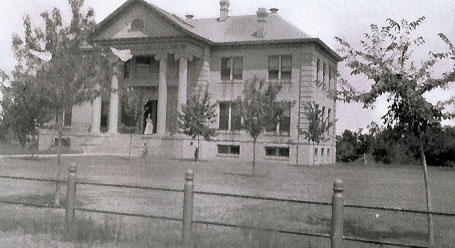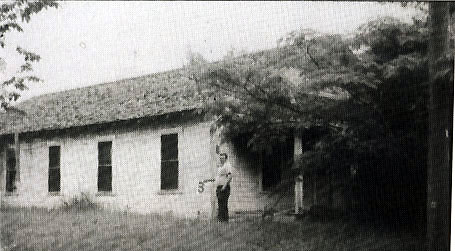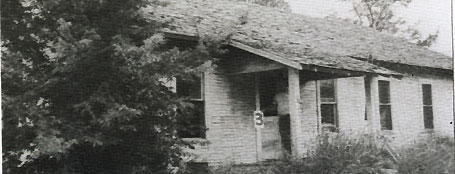Jefferson Dave Johnson was known to most as Dave Johnson. To those who knew him as a minister, he was Rev. J.D. Johnson. The Bonham Daily Favorite once described him as “one of the leading negro citizens of Bonham.” Today he might be called a community activist.
In 1935 Johnson decided it was time for Bonham and Fannin County to have a hospital for its black citizens. He immediately set about promoting and raising funds for the idea. Noting his enthusiasm, the November 18 Daily Favorite stated: “Dave usually gets what he goes after.”
The same article also noted that the directors of the Allen Memorial Hospital “agreed to assume the responsibility of directing the affairs of the new” colored hospital, and that a prominent Bonham physician, Dr. A. B. Kennedy, had donated land near Allen Memorial for the project. Finally, the article noted that financing was to come from the federal government, Fannin County and the City of Bonham, with any remaining balance to be covered by private donations.

Allen Memorial: S. B. Allen Memorial Hospital circa early 1900s. photo courtesy of Jacqueline White and the Fannin County Historical Commission

What became known as the Fannin County Colored Hospital (hereafter FCCH) did not happen overnight. Planning and funding crawled along at a snail’s pace. Even so, the Dallas Morning News of March 16, 1938 reported that money was falling into place. It noted that the city of “Bonham and Fannin County have given $1,750 needed toward completion” of the hospital, and that “federal funds will be added.”
By mid-1939 the FCCH project was quickly gaining steam. On June 12 the Bonham City Council voted to “locate contemplated hospital for negroes on portion of ground now occupied by S. B. Allen Memorial Hospital.” It further agreed to act as a sponsor for the project and authorized the mayor, Joe. B. Hrdlicka, to receive bids for its construction.
The June 14 Bonham Daily Favorite reported that building of the FCCH would begin soon and that the total cost would be roughly $3,000. The county was to give $1,000, the city $750, and the rest was to come from private contributors. No mention of federal funding this time probably means that those dollars dried up.
The same article also gave some blueprint particulars, stating that the hospital would “include four private rooms and two wards.” The whole building was to be 56 x 32 feet, with the private rooms at 10 x 12 feet, and the wards at 12 x 22 feet. “A small kitchenette,” it further noted, “is to be built in the rear, and the present plans call for two baths and two wash rooms.”

This photo was taken in the mid 1960s after the Fannin County Colored Hospital had been neglected for years. photo courtesy of Jacqueline White and the Fannin County Historical Commission

Finally, the article stated that Dave Johnson had “worked unceasingly for the project for several years,” and that other civic leaders “have assisted Johnson with his dream.”
By late summer 1939 the Daily Favorite reported that the FCCH would soon be ready for patients. The September 14 issue carried a big announcement noting that a dedication ceremony for the new hospital would be held at Bethlehem Baptist Church on Sunday, September 17. Among many local dignitaries on the speaker’s list were Rev. J. D. Johnson, Dr. A. B. Kennedy and Cong. Sam Rayburn. Afterwards, the crowd was to make the short walk to the new facility for an open house tour.
To say that the FCCH was an actual hospital would be a huge stretch of the truth. It obviously lacked an emergency room, operating rooms and the other trappings of a standard hospital. More accurately stated, it was a recovery facility for black patients who, under state law, had to receive surgical, medical or obstetric services at Allen Memorial.
Perhaps the Daily Favorite article of June 14, 1939 put it most truthfully: “The wooden building will greatly relieve the hospital and increase its capacity for white patients. It will also afford more space for colored patients than they have in the present set-up.” There was no mention of what the “present set-up” was.
Just six years after the FCCH’s opening, it lost its biggest supporter. Late in 1945 Rev. Dave Johnson came down with pneumonia and was given a private room in his cherished institution. He passed away on December 14. The physician in attendance was, of course, Dr. A. B. Kennedy.
In the following years the FCCH rolled along thanks mainly to private contributions and regular funding from the county and city. However, by 1955 the facility was in bad shape. The October 12 Bonham Daily Favorite carried a front page article reporting that the board of the FCCH and its chairman, Mr. LeRoy E. McIntyre, was making “an appeal for materials and funds with which to renovate the interior of the present structure.” There was a need for the most basic of items: shades, curtains, paint, wallpaper, towels, dishes, and, of course, cash.
McIntyre also noted “that the city and county administrations were seeking to work out a plan for the construction of a Negro hospital that would meet state specifications, but added ‘until this is done, the board has made plans to completely renovate the interior of the present hospital.’”

This photo was taken in the mid 1960s after the Fannin County Colored Hospital had been neglected for years. photo courtesy of Jacqueline White and the Fannin County Historical Commission

By the late 1950s the FCCH wasn’t alone in moanin’ the financial blues. Its parent facility, Allen Memorial, had also hit on hard times. Just how hard? The headline of the July 15, 1959 Bonham Daily Favorite stated it best: “Allen Memorial To Close Down.” And by the evening of July 17 it did just that, thanks to serious debt.
This, of course, was not good news for the FCCH; as Allen Memorial went, so did the colored hospital.
The July 15 article noted that since its beginnings in 1902, Allen Memorial had dedicated itself to taking care of Fannin County’s indigent patients. While certainly a noble policy, it is one that led to financial problems.
Fortunately, the crisis was short-lived. The Daily Favorite of Monday, July 20 reported that the Allen Memorial board met that morning to discuss reopening the hospital. Gifts from concerned citizens had eased the financial burden and allowed the board time to study ways to keep the facility open permanently.
The following Tuesday morning the hospital was open again, though on a smaller scale. Board member Claude Leatherwood was quoted saying that “only a limited number of employees would be on duty at the hospital for the time being ‘but others will be returned to work as they are needed.’”
For the FCCH, it was business as usual.
Shortly after the closing scare, community leaders busied themselves searching for new funding options for Allen Memorial. Despite their best efforts, for the next several months its financial picture remained bleak.
Unfortunately, the financial situation for the FCCH in late 1959 wasn’t any better. The October 2 Daily Favorite noted that the hospital “receives $50 per month from the county and $47 from the city to help meet expenses of operation.”
It further noted that the “three nurses employed at the hospital receive 25 cents per hour, and in addition to their nursing duties do the cooking and cleaning up.”
Finally, in an explanation of the financial problems, the article stated that due “to the large number of charity patients who are unable to pay anything, the hospital (FCCH) now has a large deficit which will approximate $3,000 at the end of the coming year.”
By mid 1960 the whole situation was starting to sound like a broken record. Once again Allen Memorial was in bad financial shape. The Daily Favorite of Wednesday, June 22 announced that the hospital was closing its doors - again. And so it did, on Friday, June 24.
The article also stated: “The closing order . . . also includes the Colored Hospital that has been operated in connection with Allen Memorial. It is the county’s only hospital for colored patients.”
This time the closing order seemed more serious and, even worse, permanent. Given that fact, Dr. E. C. Williams, the county’s health officer and a practicing physician at Medical & Surgical Clinic (M & S, opened in 1947), made a personal appeal to the Bonham City Council and the Fannin County Commissioner’s Court to continue funding of the FCCH.
The city council stated that it would continue funding only if the county did. Unfortunately, in its August 8, 1960 meeting the county commissioner’s tabled the matter and took no action on it. It began to look as though both hospitals might both be closed for good.
By early 1961 things still looked ominous when good news came in from, well, the west. Two new doctors on the Bonham scene, James Fite and Jack Vinson, had rolled in from the Lubbock area and set up practice on the second floor of the Peeler Medical Building. The March 3rd Bonham Daily Favorite reported that Fite & Vinson were going to re-open Allen Memorial Hospital, with Fite acting as administrator of the hospital, and Vinson as the chief of staff.
“Of particular interest,” the article further noted, “are plans announced by Doctor Fite to extend more suitable services for the Negro people of the county by the remodeling of the basement floor to provide 10 or 12 beds for colored patients. For the time being, it was announced, no use will be made of the present Colored hospital . . . .”
The Daily Favorite of April 9 noted that renovations to Allen Memorial had started in earnest. The May 18 issue announced the re-opening of the hospital. While the article didn’t state as much, it seems safe to assume that African American patients were admitted to the main hospital, and from that point stayed in newly renovated rooms carved out of the basement.
Though Rev. Johnson’s hospital was closed for good, its very presence had an impact. The small wooden building no doubt influenced Allen Memorial’s new directors to begin admitting patients of color to the main hospital. And it’s just as well that they did, for society was slowly moving in that direction. Bonham’s new VA hospital was already admitting veterans of color on an equal basis, and the 1964 Civil Rights Act would outlaw discrimination in all public accomodations – hospitals included. It could easily be said that Dave Johnson played at least a small role in the larger process.
Many thanks to Suzie Henderson at the Bonham Family History Center, and to Jacqueline White at the Fannin County Historical Commission. Also, to the ladies at the Bonham Public Library – especially Barbara McCutcheon, who introduced the Fannin County Colored Hospital to me.
Tim Davis teaches at Bonham High School.